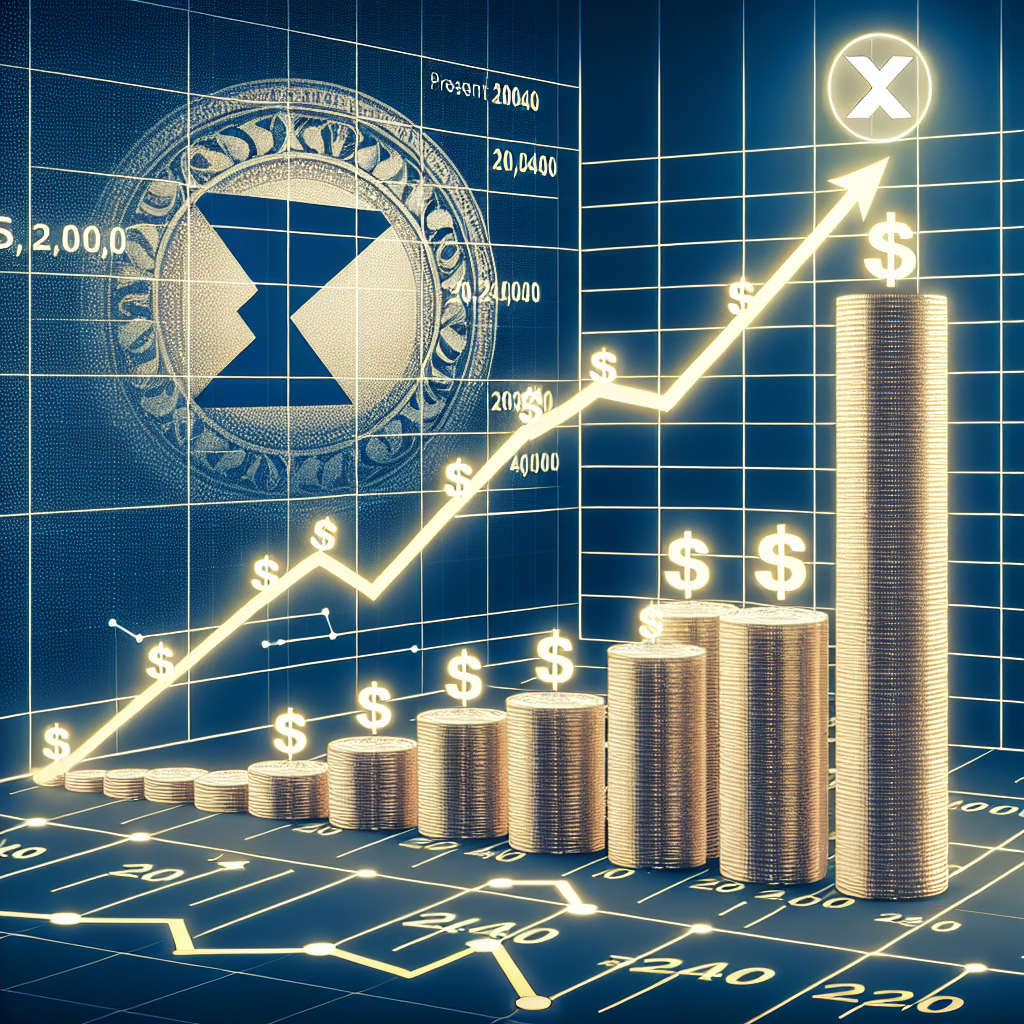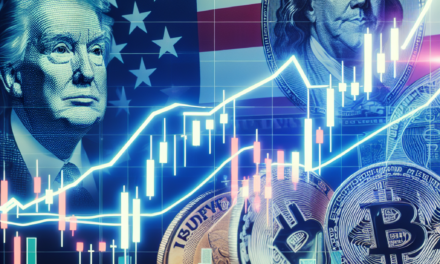“XRP 2040: Paving the Path to a Trillion-Dollar Future?”
Introduction
The prospect of XRP reaching a trillion-dollar valuation by 2040 is a topic of considerable interest and debate among investors, financial analysts, and cryptocurrency enthusiasts. As one of the leading digital assets in the cryptocurrency market, XRP has established itself as a significant player, primarily due to its association with Ripple, a company focused on facilitating cross-border payments and remittances. The potential for XRP to achieve such a monumental market capitalization hinges on several factors, including technological advancements, regulatory developments, market adoption, and the overall growth of the cryptocurrency ecosystem. Evaluating these elements provides insight into whether XRP could realistically attain a trillion-dollar valuation within the next two decades, reflecting broader trends in digital finance and the evolving landscape of global economic transactions.
Factors Influencing XRP’s Potential Trillion-Dollar Valuation by 2040
The prospect of XRP reaching a trillion-dollar valuation by 2040 is a topic of considerable interest and debate within the cryptocurrency community. Several factors could influence this potential milestone, each playing a crucial role in determining whether XRP can achieve such a significant market capitalization. To begin with, regulatory developments will be a pivotal factor. The legal landscape surrounding cryptocurrencies is continually evolving, and XRP’s future valuation will heavily depend on how regulatory bodies across the globe choose to classify and regulate digital assets. Favorable regulations could enhance investor confidence and facilitate broader adoption, while stringent regulations might pose challenges to XRP’s growth.
In addition to regulatory considerations, technological advancements will also be instrumental in shaping XRP’s trajectory. Ripple, the company behind XRP, has been actively working on improving the efficiency and scalability of its blockchain technology. As the demand for faster and more cost-effective cross-border transactions increases, XRP’s underlying technology could become a preferred solution for financial institutions. This, in turn, could drive up demand and contribute to a higher market valuation. Moreover, the integration of XRP into various financial systems and platforms could further bolster its utility and adoption, thereby enhancing its value proposition.
Another critical factor is the overall growth of the cryptocurrency market. As digital currencies become more mainstream, the market as a whole is likely to expand, potentially lifting the valuations of established cryptocurrencies like XRP. The increasing interest from institutional investors and the development of cryptocurrency-based financial products could provide additional momentum. Furthermore, the growing acceptance of cryptocurrencies as a legitimate asset class could lead to increased capital inflows, benefiting XRP and other digital assets.
Market competition, however, cannot be overlooked. XRP operates in a highly competitive environment, with numerous cryptocurrencies vying for dominance in the cross-border payment space. The emergence of new technologies and platforms could pose a threat to XRP’s market share. Therefore, Ripple’s ability to maintain a competitive edge through innovation and strategic partnerships will be crucial in determining its long-term success. Additionally, the company’s efforts to expand its network of partners and clients will play a significant role in sustaining demand for XRP.
Economic factors, such as inflation and currency fluctuations, may also impact XRP’s valuation. In times of economic uncertainty, investors often seek alternative assets to hedge against traditional market volatility. Cryptocurrencies, including XRP, could benefit from this trend, as they are perceived by some as a store of value. However, the inherent volatility of digital currencies remains a concern for many investors, which could influence their willingness to invest in XRP over the long term.
Lastly, public perception and sentiment towards cryptocurrencies will inevitably affect XRP’s potential to reach a trillion-dollar valuation. As awareness and understanding of digital assets grow, public confidence in their viability and utility could increase. Positive sentiment and widespread adoption could drive demand and contribute to a higher market capitalization. Conversely, negative perceptions or high-profile security breaches could hinder growth and deter potential investors.
In conclusion, while the possibility of XRP reaching a trillion-dollar valuation by 2040 is influenced by a myriad of factors, it remains contingent upon favorable regulatory developments, technological advancements, market dynamics, competition, economic conditions, and public sentiment. Each of these elements will play a crucial role in shaping XRP’s future, and their interplay will ultimately determine whether this ambitious milestone can be achieved.
Historical Growth Patterns of XRP and Their Implications for Future Valuation
XRP, the digital asset associated with the Ripple network, has been a subject of considerable interest and speculation within the cryptocurrency community. To understand whether XRP could reach a trillion-dollar valuation by 2040, it is essential to examine its historical growth patterns and consider the implications for its future valuation. Since its inception, XRP has experienced significant fluctuations in value, driven by various factors including market sentiment, regulatory developments, and technological advancements. Initially launched in 2012, XRP was designed to facilitate fast and cost-effective cross-border transactions, distinguishing itself from other cryptocurrencies like Bitcoin and Ethereum. Over the years, XRP has gained traction among financial institutions seeking efficient solutions for international payments, contributing to its growth.
In the early years, XRP’s value remained relatively low, reflecting the nascent stage of the cryptocurrency market. However, as the market matured and interest in digital assets surged, XRP experienced substantial price increases. Notably, during the 2017 cryptocurrency boom, XRP’s value skyrocketed, reaching an all-time high of over $3.00 in January 2018. This dramatic rise was fueled by heightened investor interest and the broader market rally. Despite this peak, XRP’s price subsequently declined, mirroring the overall market correction that followed the 2017 bull run. This volatility underscores the speculative nature of cryptocurrencies and highlights the challenges in predicting long-term valuations.
Transitioning to the present, XRP’s market performance continues to be influenced by a myriad of factors. Regulatory scrutiny, particularly in the United States, has played a significant role in shaping XRP’s trajectory. The ongoing legal battle between Ripple and the U.S. Securities and Exchange Commission (SEC) has introduced uncertainty, impacting investor confidence and market dynamics. Nevertheless, Ripple’s efforts to expand its partnerships and use cases for XRP have provided a degree of resilience. The company’s focus on fostering relationships with financial institutions and exploring new markets underscores its commitment to driving adoption and enhancing XRP’s utility.
Looking ahead, the potential for XRP to reach a trillion-dollar valuation by 2040 hinges on several key considerations. Firstly, widespread adoption of XRP as a bridge currency for cross-border transactions could significantly boost its demand and value. As the global financial landscape evolves, the need for efficient and cost-effective payment solutions is likely to grow, presenting opportunities for XRP to capture a larger market share. Additionally, technological advancements and improvements in the Ripple network’s scalability and security could enhance XRP’s appeal to both institutional and retail investors.
Moreover, regulatory clarity will be crucial in shaping XRP’s future valuation. A favorable resolution to the legal challenges faced by Ripple could pave the way for increased adoption and investment in XRP. Conversely, adverse regulatory outcomes could hinder its growth prospects. Furthermore, the broader cryptocurrency market’s trajectory will inevitably influence XRP’s valuation. As digital assets become more integrated into mainstream finance, the overall market capitalization of cryptocurrencies could expand, potentially benefiting XRP.
In conclusion, while the prospect of XRP reaching a trillion-dollar valuation by 2040 is speculative, it is not beyond the realm of possibility. Historical growth patterns provide valuable insights into the factors driving XRP’s value, while future developments in adoption, technology, and regulation will play pivotal roles in determining its trajectory. As the cryptocurrency landscape continues to evolve, XRP’s potential to achieve such a milestone will depend on its ability to navigate challenges and capitalize on emerging opportunities.
The Role of Regulatory Developments in XRP’s Path to a Trillion-Dollar Market Cap
The potential for XRP to reach a trillion-dollar valuation by 2040 is a topic of considerable interest among investors and financial analysts. Central to this discussion is the role of regulatory developments, which could significantly influence XRP’s trajectory in the coming decades. As the cryptocurrency market continues to evolve, regulatory frameworks are being established to ensure stability, security, and transparency. These frameworks are crucial for the mainstream adoption of digital assets, including XRP, and could either propel or hinder its growth.
To begin with, regulatory clarity is essential for fostering investor confidence. In recent years, the cryptocurrency market has been marred by uncertainty due to the lack of clear regulations. This ambiguity has often led to market volatility, deterring institutional investors from entering the space. However, as governments and regulatory bodies worldwide work towards establishing comprehensive guidelines, the landscape is gradually changing. For XRP, which has faced its share of legal challenges, particularly with the U.S. Securities and Exchange Commission (SEC), achieving regulatory clarity could be a game-changer. A favorable resolution to these challenges could pave the way for increased adoption and integration into the financial system, thereby enhancing its market valuation.
Moreover, regulatory developments could facilitate the integration of XRP into traditional financial systems. As financial institutions seek to leverage blockchain technology for cross-border transactions, XRP’s potential as a bridge currency becomes increasingly relevant. Regulatory approval would enable banks and financial institutions to adopt XRP without the fear of legal repercussions, thus expanding its use case and driving demand. This increased utility could significantly contribute to XRP’s market capitalization, bringing it closer to the trillion-dollar mark.
In addition to fostering adoption, regulatory frameworks could also enhance the security and stability of the XRP network. By implementing stringent security measures and compliance standards, regulators can mitigate the risks associated with fraud and cyberattacks, which have historically plagued the cryptocurrency market. A secure and stable network would not only protect investors but also attract more participants to the XRP ecosystem, further boosting its market value.
Furthermore, international cooperation on regulatory standards could play a pivotal role in XRP’s growth. As cryptocurrencies operate on a global scale, inconsistent regulations across different jurisdictions can create barriers to adoption. However, if countries collaborate to establish harmonized regulatory standards, it could facilitate cross-border transactions and increase the global acceptance of XRP. Such international alignment would be instrumental in driving XRP’s market expansion and achieving a trillion-dollar valuation.
Nevertheless, it is important to acknowledge the potential challenges that regulatory developments might pose. Overregulation could stifle innovation and limit the growth potential of XRP. Striking a balance between regulation and innovation is crucial to ensure that XRP can thrive in a competitive market while adhering to legal requirements. Policymakers must consider the unique characteristics of digital assets and develop regulations that support their growth without imposing undue restrictions.
In conclusion, regulatory developments will undoubtedly play a critical role in determining whether XRP can achieve a trillion-dollar valuation by 2040. By providing clarity, fostering adoption, enhancing security, and promoting international cooperation, regulations could significantly influence XRP’s market trajectory. However, it is essential for regulators to strike a balance that encourages innovation while ensuring compliance. As the regulatory landscape continues to evolve, the future of XRP remains intertwined with these developments, making it a subject of keen interest for stakeholders across the financial spectrum.
Technological Innovations and Their Impact on XRP’s Valuation Prospects

The potential for XRP to reach a trillion-dollar valuation by 2040 is a topic of considerable interest among investors and financial analysts. As we delve into the technological innovations that could impact XRP’s valuation prospects, it is essential to consider the broader context of the cryptocurrency market and the specific advancements that may drive XRP’s growth. To begin with, the underlying technology of XRP, the XRP Ledger, is a decentralized blockchain that facilitates fast and cost-effective cross-border transactions. This technology positions XRP as a formidable player in the realm of digital currencies, particularly in the context of international remittances and payments. As global commerce increasingly shifts towards digital solutions, the demand for efficient and reliable transaction mechanisms is likely to grow, potentially boosting XRP’s adoption and, consequently, its market valuation.
Moreover, the integration of blockchain technology into various sectors, such as finance, supply chain, and healthcare, could further enhance XRP’s utility. As these industries seek to leverage the benefits of blockchain for transparency, security, and efficiency, XRP’s role as a bridge currency could become more pronounced. This increased utility could, in turn, drive up demand and contribute to a higher valuation. Additionally, the ongoing development of smart contracts and decentralized applications (dApps) on the XRP Ledger could open new avenues for innovation and use cases. By enabling more complex financial instruments and services, these technological advancements could attract a broader user base and foster greater investment in XRP.
Furthermore, regulatory developments will play a crucial role in shaping XRP’s future valuation. As governments and regulatory bodies around the world continue to grapple with the implications of digital currencies, the establishment of clear and favorable regulatory frameworks could provide a significant boost to XRP’s prospects. Such frameworks would not only enhance investor confidence but also facilitate greater institutional adoption, which could be a key driver of XRP’s growth. In this context, it is worth noting that Ripple, the company behind XRP, has been actively engaging with regulators to promote a more conducive environment for digital assets. This proactive approach could position XRP favorably in the evolving regulatory landscape.
In addition to regulatory factors, partnerships and collaborations with financial institutions and technology companies could significantly impact XRP’s valuation. Ripple’s existing partnerships with major banks and payment providers demonstrate the potential for XRP to become an integral part of the global financial infrastructure. As these partnerships expand and deepen, they could lead to increased usage of XRP, thereby enhancing its market value. Moreover, technological innovations in areas such as interoperability and scalability could further bolster XRP’s appeal. By enabling seamless integration with other blockchain networks and improving transaction throughput, these advancements could enhance XRP’s competitiveness and attractiveness to users and investors alike.
In conclusion, while predicting the exact trajectory of XRP’s valuation by 2040 is inherently speculative, several technological innovations and developments could significantly influence its prospects. The continued evolution of the XRP Ledger, coupled with favorable regulatory developments and strategic partnerships, could pave the way for substantial growth. As the digital currency landscape continues to evolve, XRP’s ability to adapt and capitalize on these innovations will be crucial in determining whether it can achieve a trillion-dollar valuation. Ultimately, the interplay of these factors will shape XRP’s future in the dynamic and rapidly changing world of cryptocurrencies.
Comparative Analysis: XRP Versus Other Cryptocurrencies on the Trillion-Dollar Trajectory
In the rapidly evolving landscape of cryptocurrencies, the question of whether XRP could achieve a trillion-dollar valuation by 2040 invites a comparative analysis with other digital assets on a similar trajectory. As the cryptocurrency market matures, several factors come into play when assessing the potential for such a valuation, including technological innovation, regulatory developments, and market adoption. To understand XRP’s prospects, it is essential to examine its unique characteristics and compare them with other cryptocurrencies that have either reached or are projected to reach a trillion-dollar market cap.
XRP, the native digital asset of the Ripple network, distinguishes itself through its focus on facilitating cross-border payments and enhancing the efficiency of financial transactions. Unlike Bitcoin, which primarily serves as a store of value, or Ethereum, which powers decentralized applications, XRP’s utility is closely tied to the traditional financial system. This alignment with established financial institutions could be a double-edged sword. On one hand, it positions XRP to benefit from increased adoption by banks and payment providers seeking to streamline operations. On the other hand, it subjects XRP to greater scrutiny and potential regulatory hurdles, which could impact its growth trajectory.
In comparison, Bitcoin’s journey towards a trillion-dollar valuation has been driven largely by its status as “digital gold.” Its decentralized nature and limited supply have attracted investors seeking a hedge against inflation and economic uncertainty. Ethereum, meanwhile, has capitalized on its robust smart contract capabilities, fostering a vibrant ecosystem of decentralized finance (DeFi) applications and non-fungible tokens (NFTs). These distinct value propositions have enabled both Bitcoin and Ethereum to capture significant market share and investor interest.
For XRP to join the ranks of trillion-dollar cryptocurrencies, it must navigate a complex landscape of competition and regulation. One potential advantage is its transaction speed and cost efficiency, which are superior to those of Bitcoin and Ethereum. This could make XRP an attractive option for high-volume transactions and micropayments, areas where traditional cryptocurrencies face limitations. However, the ongoing legal battle between Ripple and the U.S. Securities and Exchange Commission (SEC) over the classification of XRP as a security remains a significant obstacle. The outcome of this case could set a precedent for how cryptocurrencies are regulated in the future, impacting XRP’s adoption and valuation.
Moreover, the broader cryptocurrency market is likely to undergo significant changes by 2040. Emerging technologies such as quantum computing and advancements in blockchain scalability could reshape the competitive landscape. New entrants with innovative solutions may challenge the dominance of established players like XRP, Bitcoin, and Ethereum. Therefore, XRP’s ability to adapt and evolve in response to these changes will be crucial in determining its long-term success.
In conclusion, while XRP possesses certain advantages that could propel it towards a trillion-dollar valuation, it faces formidable challenges that must be addressed. Its alignment with the traditional financial system offers both opportunities and risks, and the outcome of regulatory developments will play a pivotal role in shaping its future. By examining XRP in the context of other cryptocurrencies on the trillion-dollar trajectory, it becomes clear that a combination of technological innovation, strategic partnerships, and regulatory clarity will be essential for XRP to achieve such a milestone by 2040. As the cryptocurrency market continues to evolve, only time will tell whether XRP can realize its full potential and join the ranks of trillion-dollar digital assets.
The Influence of Global Economic Trends on XRP’s Long-Term Valuation
The potential for XRP to reach a trillion-dollar valuation by 2040 is a topic of considerable interest among investors and financial analysts. As we explore this possibility, it is essential to consider the influence of global economic trends on XRP’s long-term valuation. The cryptocurrency market, characterized by its volatility and rapid evolution, is significantly impacted by broader economic forces. Therefore, understanding these trends is crucial for assessing XRP’s future potential.
To begin with, the increasing digitization of financial systems worldwide is a pivotal trend that could bolster XRP’s valuation. As central banks and financial institutions explore digital currencies and blockchain technology, cryptocurrencies like XRP stand to benefit from increased adoption and integration into mainstream financial systems. This shift towards digital finance is driven by the need for more efficient, secure, and transparent transaction methods, which XRP, with its fast transaction speeds and low costs, is well-positioned to provide.
Moreover, the growing emphasis on cross-border transactions in a globalized economy further enhances XRP’s prospects. As businesses and individuals increasingly engage in international trade and remittances, the demand for efficient cross-border payment solutions is rising. XRP’s design as a bridge currency for facilitating seamless international transactions positions it as a valuable asset in this context. Consequently, as global trade continues to expand, XRP could see increased utilization, contributing to its long-term valuation growth.
In addition to these technological and economic shifts, regulatory developments play a crucial role in shaping XRP’s future. The regulatory landscape for cryptocurrencies is evolving, with governments worldwide grappling with how to integrate digital assets into existing financial frameworks. Positive regulatory developments, such as clear guidelines and supportive policies, could enhance investor confidence and drive greater adoption of XRP. Conversely, stringent regulations could pose challenges, potentially hindering its growth. Therefore, monitoring regulatory trends is vital for understanding XRP’s valuation trajectory.
Furthermore, macroeconomic factors such as inflation and currency devaluation could also impact XRP’s valuation. In times of economic uncertainty, investors often seek alternative assets to hedge against inflation and preserve value. Cryptocurrencies, including XRP, have emerged as potential alternatives to traditional assets like gold. If global economic instability persists, XRP could attract more investors seeking refuge from volatile fiat currencies, thereby boosting its market capitalization.
However, it is important to acknowledge the competitive landscape within the cryptocurrency market. XRP faces competition from other digital currencies and payment solutions, which could influence its market share and valuation. Innovations and advancements by competitors could challenge XRP’s position, necessitating continuous development and adaptation to maintain its relevance and appeal.
In conclusion, while the prospect of XRP reaching a trillion-dollar valuation by 2040 is speculative, it is not beyond the realm of possibility. The interplay of global economic trends, technological advancements, regulatory developments, and competitive dynamics will collectively shape XRP’s long-term valuation. As the world continues to embrace digital finance and cross-border transactions, XRP’s potential to capitalize on these trends remains significant. However, navigating the challenges posed by regulatory uncertainties and market competition will be crucial for XRP to achieve such a milestone. Ultimately, a comprehensive understanding of these factors will be essential for investors and stakeholders as they evaluate XRP’s future prospects in the ever-evolving cryptocurrency landscape.
Expert Predictions and Market Sentiments on XRP Reaching a Trillion-Dollar Valuation by 2040
The prospect of XRP reaching a trillion-dollar valuation by 2040 has sparked considerable debate among financial experts and market analysts. As the cryptocurrency market continues to evolve, the potential for digital assets like XRP to achieve unprecedented valuations is becoming a topic of increasing interest. To understand the feasibility of such a valuation, it is essential to consider various factors, including market trends, technological advancements, and regulatory developments.
Firstly, the overall growth of the cryptocurrency market plays a crucial role in determining the future valuation of XRP. Over the past decade, the market has experienced significant expansion, driven by increased adoption and the integration of blockchain technology into various sectors. If this trend continues, it could create a conducive environment for XRP to grow substantially. Moreover, the increasing acceptance of cryptocurrencies as legitimate financial instruments by institutional investors could further bolster XRP’s market position.
In addition to market growth, technological advancements within the XRP ecosystem could significantly impact its valuation. Ripple, the company behind XRP, has been actively working on enhancing the efficiency and scalability of its payment solutions. By improving transaction speeds and reducing costs, Ripple aims to position XRP as a preferred choice for cross-border payments. Should these technological improvements gain widespread adoption, they could drive demand for XRP, thereby contributing to its potential trillion-dollar valuation.
Furthermore, regulatory developments will undoubtedly influence XRP’s future valuation. The cryptocurrency market is subject to evolving regulations, which can either facilitate or hinder growth. Positive regulatory developments, such as clear guidelines and supportive policies, could encourage more widespread use of XRP. Conversely, stringent regulations could pose challenges, potentially limiting its growth prospects. Therefore, the regulatory landscape will be a critical factor in determining whether XRP can achieve a trillion-dollar valuation by 2040.
Market sentiment also plays a pivotal role in shaping the future of XRP. Investor confidence and public perception can significantly impact the demand for a cryptocurrency. Positive sentiment, driven by successful partnerships and increased utility, could enhance XRP’s appeal to investors. On the other hand, negative sentiment, possibly resulting from legal challenges or market volatility, could dampen its prospects. Thus, maintaining a positive market sentiment will be essential for XRP to reach its ambitious valuation target.
Moreover, competition within the cryptocurrency space cannot be overlooked. As new digital assets emerge and existing ones evolve, XRP will need to maintain its competitive edge. This involves not only technological innovation but also strategic partnerships and market positioning. By differentiating itself from competitors and demonstrating unique value propositions, XRP can strengthen its market presence and increase its chances of achieving a trillion-dollar valuation.
In conclusion, while the possibility of XRP reaching a trillion-dollar valuation by 2040 is intriguing, it is contingent upon a multitude of factors. The growth of the cryptocurrency market, technological advancements, regulatory developments, market sentiment, and competition will all play integral roles in shaping XRP’s future. As such, stakeholders must closely monitor these dynamics to assess the likelihood of XRP achieving this ambitious milestone. While predictions vary, the potential for XRP to reach such a valuation remains a topic of significant interest and speculation within the financial community.
Q&A
1. **What is XRP’s current market capitalization?**
As of the latest data, XRP’s market capitalization is approximately $30 billion, but this figure fluctuates with market conditions.
2. **What factors could drive XRP to a trillion-dollar valuation by 2040?**
Factors include widespread adoption of XRP for cross-border payments, regulatory clarity, partnerships with financial institutions, and overall growth in the cryptocurrency market.
3. **What challenges could prevent XRP from reaching a trillion-dollar valuation?**
Challenges include regulatory hurdles, competition from other cryptocurrencies, technological issues, and market volatility.
4. **How does XRP’s supply affect its potential valuation?**
XRP has a large supply of 100 billion tokens, which means significant demand and utility are needed to drive up its price and market cap.
5. **What role does Ripple, the company, play in XRP’s valuation?**
Ripple’s partnerships, technology development, and legal battles can significantly impact XRP’s adoption and, consequently, its valuation.
6. **How does XRP’s use case influence its market potential?**
XRP’s primary use case as a bridge currency for international transactions can enhance its demand if widely adopted by banks and financial institutions.
7. **What historical trends in the cryptocurrency market could inform XRP’s future valuation?**
Historical trends show that cryptocurrencies can experience rapid growth during bull markets, but they are also subject to significant downturns, highlighting the importance of market cycles in valuation predictions.
Conclusion
Reaching a trillion-dollar valuation by 2040 is theoretically possible for XRP, but it would require significant developments. Key factors include widespread adoption of XRP for cross-border payments, regulatory clarity, technological advancements, and overall growth in the cryptocurrency market. Additionally, XRP would need to maintain a competitive edge over other digital assets and traditional financial systems. While the potential exists, achieving such a valuation would depend on a combination of favorable market conditions, strategic partnerships, and sustained innovation.





